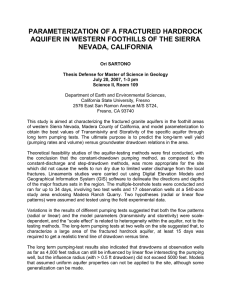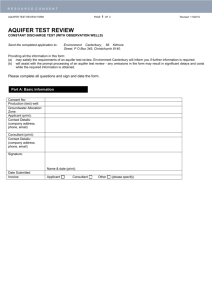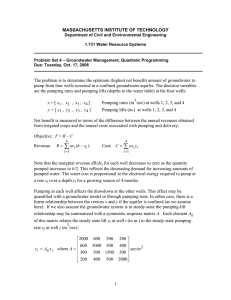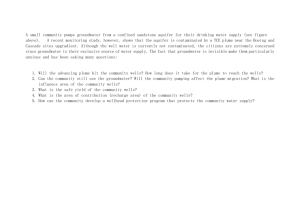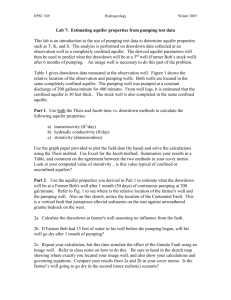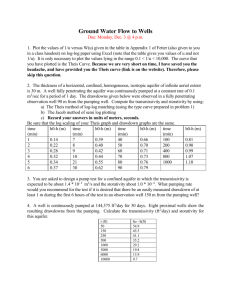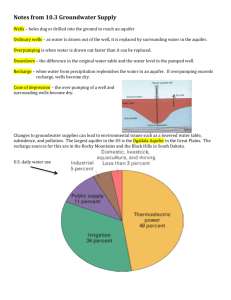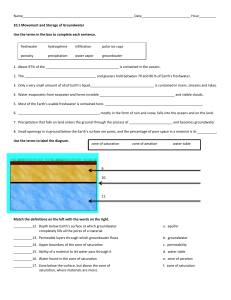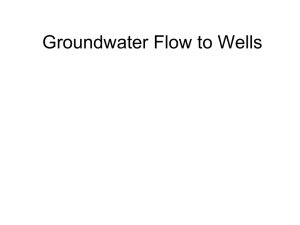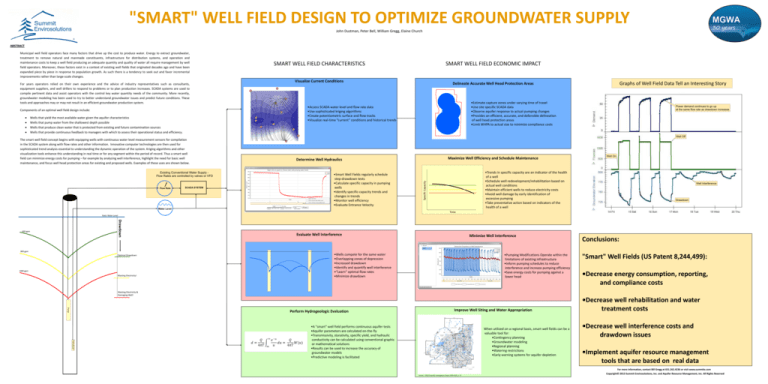
"SMART" WELL FIELD DESIGN TO OPTIMIZE GROUNDWATER SUPPLY
John Dustman, Peter Bell, William Gregg, Elaine Church
ABSTRACT
For years operators relied on their own experience and the advice of industry representatives such as consultants,
equipment suppliers, and well drillers to respond to problems or to plan production increases. SCADA systems are used to
compile pertinent data and assist operators with the control key water quantity needs of the community. More recently,
groundwater modeling has been used to try to better understand groundwater issues and predict future conditions. These
tools and approaches may or may not result in an efficient groundwater production system.
Components of an optimal well field design include:
Wells that yield the most available water given the aquifer characteristics
Wells that pump water from the shallowest depth possible
Wells that produce clean water that is protected from existing and future contamination sources
Wells that provide continuous feedback to managers with which to assess their operational status and efficiency.
The smart well field concept begins with equipping wells with continuous water level measurement sensors for compilation
in the SCADA system along with flow rates and other information. Innovative computer technologies are then used for
sophisticated trend analysis essential to understanding the dynamic operation of the system. Kriging algorithms and other
visualization tools enhance this understanding in real time or for any segment within the period of record. Thus a smart well
field can minimize energy costs for pumping – for example by analyzing well interference, highlight the need for basic well
maintenance, and focus well head protection areas for existing and proposed wells. Examples of these uses are shown below.
Existing Conventional Water Supply Flow Rates are controlled by valves or VFD
Flow Rate
Water Level
SCADA SYSTEM
SMART WELL FIELD CHARACTERISTICS
Visualize Current Conditions
Drawdown
800 gpm
Optimal Drawdown
1000 gpm
Wasting Electricity!
Graphs of Well Field Data Tell an Interesting Story
Delineate Accurate Well Head Protection Areas
•Estimate capture zones under varying time of travel
•Use site specific SCADA data
•Observe aquifer response to actual pumping changes
•Provides an efficient, accurate, and defensible delineation
of well head protection areas
•Limit WHPA to actual size to minimize compliance costs
•Access SCADA water level and flow rate data
•Use sophisticated kriging algorithms
•Create potentiometric surface and flow tracks
•Visualize real-time “current” conditions and historical trends
Power demand continues to go up
at the same flow rate as drawdown increases
Well Off
Maximize Well Efficiency and Schedule Maintenance
Determine Well Hydraulics
•Smart Well Fields regularly schedule
step-drawdown tests
•Calculate specific capacity in pumping
wells
•Identify specific-capacity trends and
changes in trends
•Monitor well efficiency
•Evaluate Entrance Velocity
Time
Static Water Level
600 gpm
SMART WELL FIELD ECONOMIC IMPACT
Specifc Capacity
Municipal well field operators face many factors that drive up the cost to produce water. Energy to extract groundwater,
treatment to remove natural and manmade constituents, infrastructure for distribution systems, and operation and
maintenance costs to keep a well field producing an adequate quantity and quality of water all require management by well
field operators. Moreover, these factors exist in a context of existing well fields that originated decades ago and have been
expanded piece by piece in response to population growth. As such there is a tendency to seek out and favor incremental
improvements rather than large-scale changes.
Evaluate Well Interference
•Trends in specific capacity are an indicator of the health
of a well
•Schedule well redevelopment/rehabilitation based on
actual well conditions
•Maintain efficient wells to reduce electricity costs
•Avoid well damage by early identification of
excessive pumping
•Take preventative action based on indicators of the
health of a well
Minimize Well Interference
•Wells compete for the same water
•Overlapping cones of depression
•Increased drawdown
•Identify and quantify well interference
•“Learn” optimal flow rates
•Minimize drawdown
•Pumping Modifications Operate within the
limitations of existing infrastructure
•Inform pumping schedules to reduce
interference and increase pumping efficiency
•Save energy costs for pumping against a
lower head
Wasting Electricity &
Damaging Well!
Pump
Perform Hydrogeologic Evaluation
Improve Well Siting and Water Appropriation
Transducer
•A "smart" well field performs continuous aquifer tests
•Aquifer parameters are calculated on-the-fly
•Transmissivity, storativity, specific yield, and hydraulic
conductivity can be calculated using conventional graphic
or mathematical solutions
•Results can be used to increase the accuracy of
groundwater models
•Predictive modeling is facilitated
Well On
When utilized on a regional basis, smart well fields can be a
valuable tool for:
•Contingency planning
•Groundwater modeling
•Regional planning
•Watering restrictions
•Early warning systems for aquifer depletion
Well Interference
Drawdown
Conclusions:
"Smart" Well Fields (US Patent 8,244,499):
•Decrease energy consumption, reporting,
and compliance costs
•Decrease well rehabilitation and water
treatment costs
•Decrease well interference costs and
drawdown issues
•Implement aquifer resource management
tools that are based on real data
For more information, contact Bill Gregg at 651.262.4236 or visit www.summite.com
Source: USGS Scientific Investigations Report 2009-5226, p. 12.
Copyright© 2013 Summit Envirosolutions, Inc. and Aquifer Resource Management, Inc. All Rights Reserved

